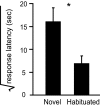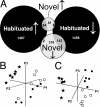Discrete molecular states in the brain accompany changing responses to a vocal signal
- PMID: 19541599
- PMCID: PMC2708759
- DOI: 10.1073/pnas.0812998106
Discrete molecular states in the brain accompany changing responses to a vocal signal
Abstract
New experiences can trigger changes in gene expression in the brain. To understand this phenomenon better, we studied zebra finches hearing playbacks of birdsong. Earlier research had shown that initial playbacks of a novel song transiently increase the ZENK (ZIF-268, EGR1, NGFIA, KROX-24) mRNA in the auditory forebrain, but the response selectively habituates after repetition of the stimulus. Here, using DNA microarray analysis, we show that novel song exposure induces rapid changes in thousands of RNAs, with even more RNAs decreasing than increasing. Habituation training leads to the emergence of a different gene expression profile a day later, accompanied by loss of essentially all of the rapid "novel" molecular responses. The novel molecular profile is characterized by increases in genes involved in transcription and RNA processing and decreases in ion channels and putative noncoding RNAs. The "habituated" profile is dominated by changes in genes for mitochondrial proteins. A parallel proteomic analysis [2-dimensional difference gel electrophoresis (2D-DIGE) and sequencing by mass spectrometry] also detected changes in mitochondrial proteins, and direct enzyme assay demonstrated changes in both complexes I and IV in the habituated state. Thus a natural experience, in this case hearing the sound of birdsong, can lead to major shifts in energetics and macromolecular metabolism in higher centers in the brain.
Conflict of interest statement
The authors declare no conflict of interest.
Figures




Similar articles
-
Context-specific habituation of the zenk gene response to song in adult zebra finches.Neurobiol Learn Mem. 2004 Sep;82(2):99-108. doi: 10.1016/j.nlm.2004.05.001. Neurobiol Learn Mem. 2004. PMID: 15341795
-
Partial dissociation of molecular and behavioral measures of song habituation in adult zebra finches.Genes Brain Behav. 2008 Oct;7(7):802-9. doi: 10.1111/j.1601-183X.2008.00423.x. Genes Brain Behav. 2008. PMID: 19125865 Free PMC article.
-
Song presentation induces gene expression in the songbird forebrain.Proc Natl Acad Sci U S A. 1992 Aug 1;89(15):6818-22. doi: 10.1073/pnas.89.15.6818. Proc Natl Acad Sci U S A. 1992. PMID: 1495970 Free PMC article.
-
Developmental shifts in gene expression in the auditory forebrain during the sensitive period for song learning.Dev Neurobiol. 2009 Jun;69(7):437-50. doi: 10.1002/dneu.20719. Dev Neurobiol. 2009. PMID: 19360720 Free PMC article.
-
Sound sequences in birdsong: how much do birds really care?Philos Trans R Soc Lond B Biol Sci. 2020 Jan 6;375(1789):20190044. doi: 10.1098/rstb.2019.0044. Epub 2019 Nov 18. Philos Trans R Soc Lond B Biol Sci. 2020. PMID: 31735149 Free PMC article. Review.
Cited by
-
The genome of a songbird.Nature. 2010 Apr 1;464(7289):757-62. doi: 10.1038/nature08819. Nature. 2010. PMID: 20360741 Free PMC article.
-
Genomewide analysis of rat barrel cortex reveals time- and layer-specific mRNA expression changes related to experience-dependent plasticity.J Neurosci. 2011 Apr 20;31(16):6140-58. doi: 10.1523/JNEUROSCI.6514-10.2011. J Neurosci. 2011. PMID: 21508239 Free PMC article.
-
Cell type-specific genes show striking and distinct patterns of spatial expression in the mouse brain.Proc Natl Acad Sci U S A. 2013 Feb 19;110(8):3095-100. doi: 10.1073/pnas.1222897110. Epub 2013 Feb 5. Proc Natl Acad Sci U S A. 2013. PMID: 23386717 Free PMC article.
-
What can whole genome expression data tell us about the ecology and evolution of personality?Philos Trans R Soc Lond B Biol Sci. 2010 Dec 27;365(1560):4001-12. doi: 10.1098/rstb.2010.0185. Philos Trans R Soc Lond B Biol Sci. 2010. PMID: 21078652 Free PMC article. Review.
-
Curation of microarray oligonucleotides and corresponding ESTs/cDNAs used for gene expression analysis in zebra finches.BMC Res Notes. 2018 May 18;11(1):309. doi: 10.1186/s13104-018-3402-x. BMC Res Notes. 2018. PMID: 29776372 Free PMC article.
References
-
- Clayton DF. The genomic action potential. Neurobiol Learn Mem. 2000;74:185–216. - PubMed
Publication types
MeSH terms
Substances
Grants and funding
LinkOut - more resources
Full Text Sources
Molecular Biology Databases

